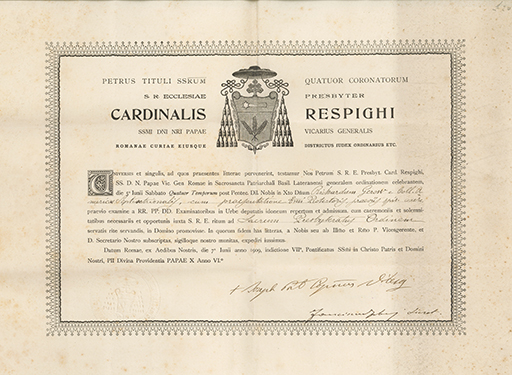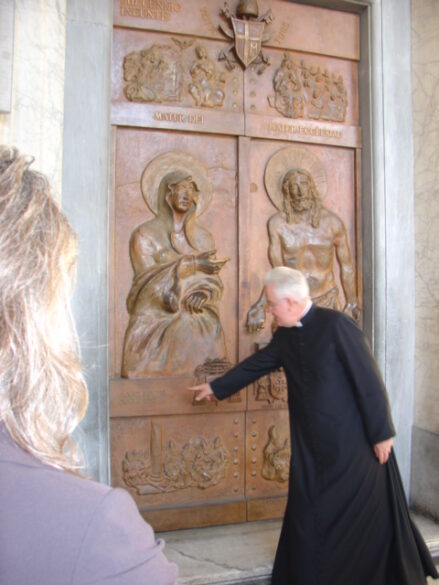From the Archives
By Mary Woodward
While flipping through Bishop Richard Gerow’s Reminiscences I came across a photo he took of the exterior of his home parish church in Mobile. The photo is from the Conti Street side near the rear of the Cathedral Basilica of the Immaculate Conception.
Bishop Gerow grew up in the shadows of the Cathedral in the heart of Downtown Mobile. He was baptized, received first communion, confirmed and ordained a bishop there. His family lived a few blocks from the historic church, and he served Mass there almost daily as a young boy before heading off to college and ultimately seminary in Rome.
An avid photographer, Bishop Gerow took photos throughout his life and his photo collection in our archives has helped document the history of early 1900s Mobile and Rome and all places in between where he travelled. He captured the churches, people, buildings, and other various slices of life in our diocese from 1924 – 1966 during his tenure as chief shepherd in Mississippi.
Photos are essential tools in archival work to document and date the history of a particular time and location through visual images. This is one of the more fun parts of archival research.
This particular photo of the exterior of his beloved Mobile Cathedral shows the beauty of the structure in black and white, but something one would never really notice is a small magnolia tree halfway down the side of the church. The photo dates to around 1910 after Bishop Gerow’s return to Mobile from Rome following his ordination to the priesthood in 1909.
If you travelled to Mobile today, that little starter tree is still there. Now, it rises majestically to the roof line of the church and spreads its massive network of limbs throughout this section of the cathedral gardens.
I have heard many people walking past it wondering aloud how old the tree might be. Because we have the 1910 photo, we can better answer that question by saying it is at least 115.
I took a photo of the tree in September 2023, while I was waiting to be freed from the cathedral garden after I had been locked inside the gate on a Friday afternoon. The light was still good, and I tried to capture the centenarian and its sprawling limbs.
The planter of the tree is long gone and unknown to me. Perhaps there is some record of it in the Mobile archdiocesan archive. This magnolia is a wonderful testament to the proverb that the one who plants a tree for others in the future to enjoy its shade has begun to understand the meaning of life.
That tree has shaded many young men on their way to ordination. It has provided a backdrop for countless marriage proposals in the gardens it towers over. And it provides shade for so many on hot summer days.
The Mobile magnolia has journeyed from a small bundle of potential to a wise elder gracing the grounds of history. Bishop Gerow certainly would be impressed and happy to see it now.
More from Bishop Gerow’s Reminiscences next time. In the meantime, enjoy the shade as we transition into the fall of the year.
(Mary Woodward is Chancellor and Archivist for the Diocese of Jackson.)


MOBILE – A circa 1910 photo taken by Bishop Richard Gerow (above) shows a newly planted magnolia tree, circled in red, outside the Cathedral Basilica of the Immaculate Conception. More than a century later, the same tree (left) now towers to the roofline, shading the cathedral gardens. (Archive photo from the Diocese of Jackson Archives; recent photo by Mary Woodward)















